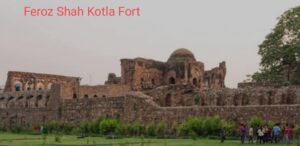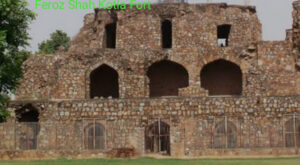Feroz Shah Kotla Fort is one of Delhi’s oldest and most historically significant landmarks, often overlooked by tourists in favor of more popular attractions. This fort, built during the 14th century, stands as a testament to the grandiose vision of Sultan Feroz Shah Tughlaq, the ruler of the Tughlaq dynasty. It not only served as a political and administrative center during the Sultan’s reign but also holds a fascinating connection to ancient India through the Ashokan Pillar. Today, Feroz Shah Kotla is a blend of history, architecture, and mysticism, making it a unique site for both history enthusiasts and spiritual seekers.
In this blog post, we’ll dive deep into the history, architectural splendor, spiritual significance, and current state of the fort, providing an enriching guide for anyone looking to visit this forgotten gem of Delhi.

1. The Origins of Feroz Shah Kotla Fort
Feroz Shah Kotla Fort was commissioned by Sultan Feroz Shah Tughlaq in 1354 CE. Feroz Shah was the third ruler of the Tughlaq dynasty, known for his administrative skills and architectural innovations. After inheriting a fractured empire from his predecessors, Feroz Shah sought to solidify his reign by building a new capital, Ferozabad, on the banks of the Yamuna River. Feroz Shah Kotla was at the heart of this new city.
The primary purpose of the fort was to function as a royal palace and administrative hub. It was a symbol of power, grandeur, and architectural ambition, designed to project the strength of the Tughlaq dynasty. The fort was not only a political center but also a residence for the royal family, with beautifully constructed mosques, gardens, and courts.
2. Architecture and Layout of the Fort
Feroz Shah Kotla Fort’s architecture reflects a fusion of Indo-Islamic styles, which were typical of the Tughlaq era. The fort, though now in ruins, still offers glimpses of its former grandeur. Some of the key architectural features that still stand include:
– Ashokan Pillar (Lat): One of the most striking elements of the fort is the Ashokan Pillar, which was originally erected by the Mauryan Emperor Ashoka in the 3rd century BCE. Feroz Shah brought the pillar to Delhi from Topra (in present-day Haryana) and installed it atop a pyramidal structure within the fort. This pillar, carved with edicts of Ashoka in Brahmi script, connects the fort to ancient Indian history and reflects Feroz Shah’s appreciation for his predecessors.
– Baoli (Stepwell): The fort contains a baoli or stepwell, which was an important water source for the inhabitants of the fort. Stepwells were commonly built in medieval India, serving both practical and aesthetic purposes.
– Jami Masjid: Another prominent feature of the fort is the Jami Masjid, one of the oldest and largest mosques of its time. This mosque was used by the royal family and courtiers for Friday prayers. Its simple yet imposing structure speaks to the religious significance of the fort during the Tughlaq period.
The fort’s layout, with its massive stone walls, expansive courtyards, and remnants of palaces, offers a glimpse into the architectural vision of Feroz Shah, which was centered on both defense and aesthetic appeal.

3. The Spiritual and Mystical Connection
One of the most unique aspects of Feroz Shah Kotla Fort is its association with the supernatural. Over the years, the fort has gained a reputation as a place where djinns (supernatural beings in Islamic mythology) reside. Local legend holds that the djinns of Feroz Shah Kotla grant wishes and solve the problems of those who seek their help.
Every Thursday, people from various parts of Delhi visit the fort to offer prayers, write letters, and light candles, all in the hope of receiving favors from these mystical beings. Some even leave notes on the walls of the ruins, asking the djinns for guidance or assistance in their personal lives. This spiritual practice has turned the fort into a hub of faith and mysticism.
The belief in djinns and their powers has contributed significantly to the fort’s modern-day mystique, drawing visitors not only for its historical importance but also for its supernatural aura.
4. Feroz Shah Kotla Through the Ages
After the decline of the Tughlaq dynasty, Feroz Shah Kotla Fort lost much of its political significance. The rise of the Mughal Empire and their establishment of a new capital in Shahjahanabad (modern-day Old Delhi) further overshadowed the fort. While the Mughals maintained control over the region, Feroz Shah Kotla became increasingly neglected.
During the British colonial era, the fort suffered further degradation. Many of its structures were dismantled, and the stones were repurposed for other construction projects. By the time India gained independence, Feroz Shah Kotla had become little more than a shadow of its former self, with only ruins remaining to tell its story.
Despite its state of disrepair, the fort still stands as a symbol of the Tughlaq dynasty’s architectural legacy and Delhi’s medieval history. Today, efforts are being made to preserve what remains of the fort.
5. The Historical Significance of Feroz Shah Kotla Fort
Feroz Shah Kotla Fort plays an important role in Delhi’s historical narrative. It reflects not only the grandeur of the Tughlaq dynasty but also the Sultan’s contributions to urban planning and infrastructure development. Feroz Shah was a visionary leader who introduced several public works, including the construction of canals, mosques, and gardens.
The Ashokan Pillar within the fort adds another layer of historical importance. This pillar, inscribed with edicts promoting non-violence and moral conduct, serves as a link between Feroz Shah’s reign and ancient India. The relocation of this pillar to Delhi illustrates Feroz Shah’s efforts to associate himself with India’s ancient kings and rulers, thereby reinforcing his legitimacy.
The fort’s importance extends beyond its architectural and political significance; it was a cultural center that shaped the lives of the people living in Ferozabad. It played a crucial role in Delhi’s transition from ancient to medieval times.
6. Visiting Feroz Shah Kotla Fort Today
Visiting Feroz Shah Kotla Fort today offers a unique experience, blending history, architecture, and mysticism. Here’s some practical information for visitors:
– Location: The fort is located in central Delhi, close to the Feroz Shah Kotla cricket stadium.
– Timings: The fort is open from 9 AM to 5 PM every day.
– Entry Fee: Tickets are reasonably priced at ₹15 for Indian citizens and ₹200 for foreign tourists.
The best time to visit is during the cooler months, from October to March, as Delhi’s summer heat can make exploring the fort uncomfortable. Visitors should plan to spend a few hours exploring the fort’s ruins, particularly the Ashokan Pillar, Baoli, and Jami Masjid.
Nearby attractions include the Red Fort, India Gate, and the National Zoological Park, making Feroz Shah Kotla an ideal stop for those interested in Delhi’s historical landmarks.
7. Feroz Shah Kotla Fort in Pop Culture
Feroz Shah Kotla Fort has also found its place in popular culture, often depicted as a place of mystery and supernatural intrigue. Numerous books, films, and documentaries have explored the fort’s haunted reputation, adding to its allure. One of the most famous references to the fort’s mystical nature comes from the novel *The Djinns of Delhi*, which explores the legends surrounding the fort and its connection to the supernatural.
The fort has also been used as a filming location for several Bollywood movies, where its ancient ruins provide a dramatic backdrop for historical and fantasy scenes.
8. Preservation and Conservation Efforts
Despite its rich history, Feroz Shah Kotla Fort faces numerous challenges in terms of preservation. Urbanization, pollution, and neglect have taken a toll on the fort’s structures. However, the Archaeological Survey of India (ASI) has been working to preserve what remains of the fort through conservation efforts. Restoration work has been carried out on the Ashokan Pillar, and parts of the Jami Masjid have been stabilized.
Local heritage activists are also raising awareness about the fort’s historical significance and the need for its preservation. Sustainable tourism practices, such as encouraging visitors to respect the site and avoid littering, can also contribute to the fort’s long-term survival.
Conclusion :
Feroz Shah Kotla Fort is more than just a relic of the past; it is a symbol of Delhi’s layered history, blending political ambition, architectural brilliance, and spiritual mysticism. Though it may not receive the same attention as other monuments in the city, it holds a special place in the hearts of those who seek to understand Delhi’s medieval past. Whether you are a history enthusiast, an architecture lover, or a spiritual seeker, Feroz Shah Kotla Fort offers an experience like no other.
If you haven’t already, make sure to add Feroz Shah Kotla Fort to your list of must-visit places in Delhi. With its unique combination of history, culture, and mysticism, it is truly a hidden gem waiting to be discovered.
FAQs:
1.Why is Feroz Shah Kotla famous?
2.What is the haunted story of Feroz Shah Kotla Stadium?
3.What is the fort of Firoz Shah Tughlaq?
4.What are the features of Feroz Shah Kotla Fort?
5.Feroz Shah Kotla Fort Ticket Price
6.Who built Feroz Shah Kotla stadium
7.Feroz Shah Kotla images
8.Feroz Shah Kotla metro station
9.Feroz Shah Kotla Stadium today match
10.Feroz Shah Kotla history

